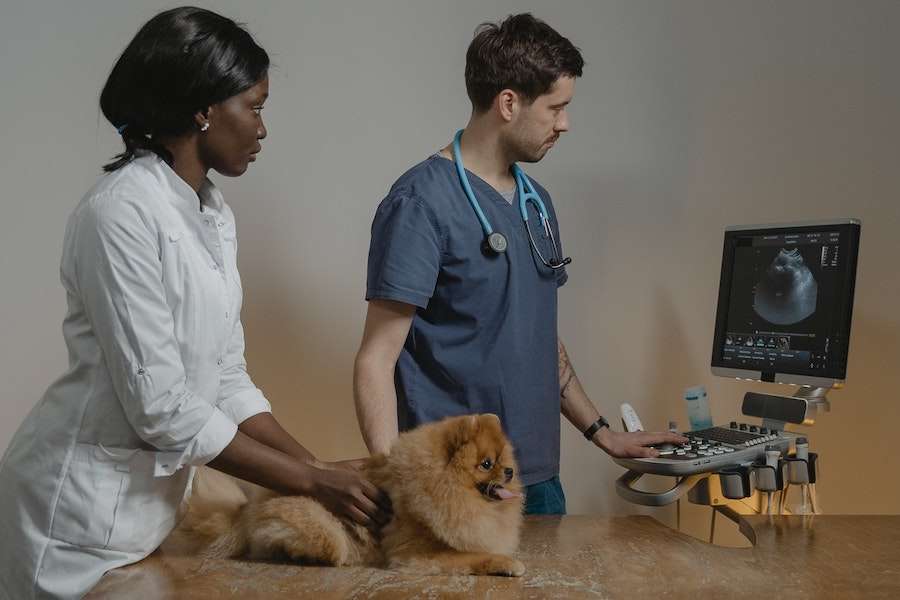The Dog Tale is reader-supported. We may earn a commission if you buy something through our site; this doesn’t change our recommendations.
Just as with any part of a dog’s body, a female dog can be inflamed around her vulva and vagina. This inflammation can be caused by a number of problems and the treatment depends on the cause. If you notice any of the clinical signs of vaginitis in your dog, it’s important to have your dog examined by a veterinarian right away.
We’ll discuss the symptoms, causes, diagnosis, and treatment of vaginitis in dogs in this guide.
- Protect your pet in seconds
- Accident & Illness + Optional Wellness coverage available
- Policies start at just $9.99/mo
In this guide:
- What is vaginitis?
- Symptoms of vaginitis in dogs
- What causes vaginitis in dogs?
- Diagnosing dog vaginitis
- How to treat vaginitis in dogs
- How to handle chronic vaginitis in adult dogs
What is vaginitis in dogs?
Vaginitis is a catch-all term that refers to inflammation of the vagina. It may affect both spayed and intact female dogs and can occur before puberty or in mature female dogs. Dogs with vaginitis may appear healthy, excluding their private areas.
There are two types of canine vaginitis: juvenile vaginitis and adult-onset vaginitis. The severity, cause, and treatment are typically different between the two groups, with puppies often fairing better. Learn more about puppy vaginitis.
In some cases, adult dogs with vaginitis will have a co-existing health issue, such as diabetes or liver disease, which can make the situation worse. Adult-onset vaginitis occurs more often in spayed females rather than intact female dogs.
Symptoms of vaginitis in dogs
There are several signs indicating the presence of canine vaginitis, and some of them can be confused with the heat cycle. The following symptoms are typical of adult-onset vaginitis.
The most common clinical sign is abnormal discharge from the vulva. This discharge may appear as mucus, pus, or even blood, and it may be found on her fur, bed, or other places where she lies. She may attempt to clean herself by excessively licking her vulvar area or she may scoot or rub herself on the ground, both of which can further irritate and inflame the skin.
Other clinical signs of vaginitis include frequent urination (sometimes in inappropriate locations), urinary incontinence, and swelling and redness around the dog’s private parts. Often, male dogs will be attracted to females with vaginitis even though they are not in their heat cycle.
It will be important to tell your vet about your dog’s medical history, such as frequency of urination, so they can assess what might be the issue.
>> Read more: Lemonade Pet Insurance Review
What causes vaginitis in dogs?
Urinary tract infection
Dog vaginitis is primarily due to bacterial urinary tract infection. Dr. Karen Becker indicates this type of infection may be the “result of the constriction of the vagina caused by a conformational [i.e. anatomical] abnormality.”
If the dog has a bladder infection, the bacteria-filled urine leaves the bladder and infects the vagina as well. According to Margaret V. R. Kustritz, DVM, the most common bacterial culprits are Escherichia coli and Staphylococcus aureus.
Urine on the vaginal membrane
Dr. Becker also points out the infection could be due to the presence of urine on the vaginal mucosa, or the membrane inside of the vagina. The urine can be irritating to this membrane. But since all female dogs pass urine through their vagina, it points to an issue of the urine itself: a pH issue, urinary crystals, or possibly a urinary outflow abnormality.
>> Read more: What Is a Dog’s Skin pH?
Urinary incontinence
Dogs struggling with urinary incontinence leak urine, which can inflame the vagina membrane leading to a localized bacterial infection.
Yeast, viruses, and bacteria
Yeast, viruses, bacteria, and fecal contamination can also cause vaginitis. These can transfer to the dog’s vaginal area when the dog cleans herself by licking after pooping. Yeast infections can occur when dogs are immunocompromised or are on lengthy antibiotic treatment. Viral infections, (e.g. herpes) can cause vaginitis.
Allergens or irritants
Certain products used on dogs, such as shampoos, conditioners, or sprays can cause this area to become irritated. Regular use of dog wipes on the delicate vaginal area can cause vaginitis, which is why it’s important to look for a gentle, chemical-free wipe if you use them frequently.
>> Read more: Best Dog Eye Wipes
Other causes
Other causes include vaginal trauma, a recessed vulva, a foreign body in the vagina, use of steroids, tumors, vaginal abscess, zinc poisoning, vaginal hyperplasia (swelling of the vaginal mucosa).
>> Read more: Why Is My Female Dog’s Private Area Swollen?
Diagnosing dog vaginitis
Your vet will complete at least one diagnostic test to determine the source of the vaginitis as well as the most effective treatment.
- Cytological examination: A sample of the cells from the vagina and vaginal discharge is examined under a microscope.
- Vaginal and urine bacterial culture and sensitivity testing: Testing vaginal cultures or a urine culture to determine if there are bacteria causing the problem and what kind of medication will be most effective in treating the infection.
- Urinalysis testing: Urine tests will check for pH issues or urinary crystals.
- Manual vaginal examination: A physical examination of the vaginal area.
- Vaginoscopy: Using a camera to visually examine the vaginal walls and tissues for the presence of anything abnormal, such as urine pooling, cysts, polyps, masses, and foreign bodies.
- Ultrasound or X-ray: Looking for tumors, bladder changes, foreign bodies, or tissue abnormalities in the reproductive organs.
- Blood chemistry profile and complete blood count, electrolyte profile: These tests may indicate the presence of inflammation, abnormal hormone levels, pregnancy, or other health concerns.
- Canine brucellosis test: Brucellosis is a contagious bacterial infection that can cause a number of reproductive problems, including infertility and abortion in breeding dogs. This test is only completed in adult dogs.
How to treat vaginitis in dogs
Since the primary cause of vaginitis in dogs is a urinary tract infection, it is important to get medical help right away. Delaying veterinary treatment for vaginitis could make the problem worse. Treating vaginitis in dogs is most effective when it’s based on diagnostic test results.
In the case of persistent infection in adult dogs, antibiotics are usually administered. With antibiotics, Dr. Becker recommends insisting your dog receive a culture and sensitivity test. This test will determine which antibiotic treatment will be most effective to fight the infection. Using the wrong antibiotic can cause the growth of additional bacteria and create the right environment for yeast infection.
In the case of urinary incontinence, this issue must be resolved before dealing with vaginitis. In spayed dogs, the cause of the incontinence tends to be hormonal.
In recurrent vaginitis, Dr. Becker recommends a dairy-free, broad-spectrum probiotic to keep a balance of bacteria levels. Ask your vet about using a clean, damp washcloth, mild dog wipes, or vaginal douches to clean around the vulva on a daily basis.
- Protect your pet in seconds
- Accident & Illness + Optional Wellness coverage available
- Policies start at just $9.99/mo
How to handle chronic vaginitis in adult dogs
When vaginitis in a puppy does not clear up and becomes chronic adult vaginitis, your vet may choose to complete immunoglobulin testing to determine your dog’s level of immune function. Your dog may be lacking IgA—an antibody that plays an important role in the immune function of mucous membranes. Many dogs with IgA deficiencies have recurring infections.
According to veterinarian Cheri Johnson, when a female dog older than one year displays chronic vaginitis, the inflammation tends to be primarily associated with anatomical abnormalities and, secondarily, urinary tract issues.
If one of these two issues is causing vaginitis, they need to be resolved for the inflammation to subside. Seek out the help of your veterinarian to treat chronic vaginitis. Your vet will likely perform an examination and several diagnostic tests to determine the source of the problem. It’s possible that surgery or medication may be needed to treat the primary issue.
>> Read more: Unhealthiest Dog Breeds
Pumpkin Pet Insurance Review
Wagmo Pet Insurance Review: Wellness Plans & Coverage for Accidents


